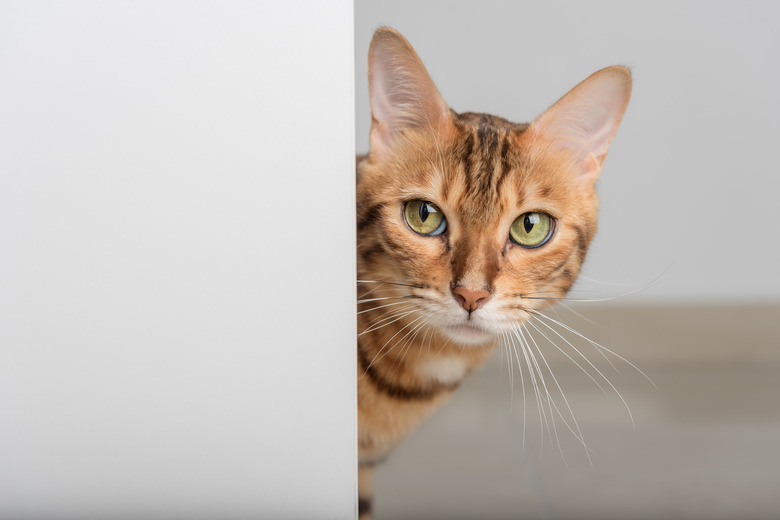Lymphoma In Cats
Lymphoma is the most commonly diagnosed cancer in cats. There are several types of lymphoma that affect different parts of the body but they are all cancers of the lymphocyte and the lymphatic system (or lymphoid system.) Lymphocytes are a type of white blood cells that are present in every organ of the body. Since they are part of the immune system, they defend your cat's body against infection and cancer cells. But sometimes lymphocytes can mutate and the diseased cells reproduce uncontrollably, resulting in lymphoma.
Risk factors for feline lymphoma
Risk factors for feline lymphoma
Though any cat can develop lymphoma, older cats that are 10 to 12 years of age are more likely to be diagnosed with it. Cats who spend more time outdoors, especially if they are unvaccinated for feline leukemia virus (FeLV,) are also at increased risk. You can reduce your cat's risk by keeping them indoors or if that's not possible, keeping them current on the FeLV vaccination.
Feline immunodeficiency virus (FIV) infection is also a risk factor for your cat developing lymphoma but not as much of a risk as FeLV. Currently, there is no commercially available FIV vaccine in North America so if your cat spends time outside and gets into fights, they are more at risk for FIV.
Types of lymphoma and clinical signs
Gastrointestinal or alimentary lymphoma
This is the most common form, accounting for up to 70% of feline lymphoma cases. There are two types: small cell lymphoma and large cell lymphoma.
Large cell lymphoma is more aggressive and will cause a mass, or tumor, in the stomach and/or intestines (particularly the small intestines.) It also usually affects lymph nodes in the abdomen.
Small cell lymphoma is less malignant and has less severe symptoms than the large cell version. Unlike large cell lymphoma which creates a hard tumor, the small cell form creates areas of intestinal thickening. This type of lymphoma may or may not affect abdominal lymph nodes. Due to the commonality of feline inflammatory bowel disease (IBD,) it's worth noting that cats with small cell lymphoma also often have IBD.
Clinical signs for gastrointestinal lymphoma include weight loss, decreased appetite, increased appetite, vomiting and diarrhea. Feline leukemia virus is not usually associated with this form of lymphoma.
Renal lymphoma
This type of feline lymphoma affects the kidneys. As healthy kidney cells become replaced with cancerous ones, it causes clinical signs similar to chronic kidney disease. This includes increased thirst, increased urination, vomiting, and weight loss. Renal lymphoma can sometimes spread to the central nervous system. Cats with feline leukemia are more likely to be affected.
Mediastinal lymphoma
This type of lymphoma creates a tumor in a part of the chest cavity between the lungs, called the mediastinum. It often affects young cats and cats with FeLV. Clinical signs include weight loss, decreased appetite, coughing and trouble breathing.
Miscellaneous types of feline lymphoma
Other forms of lymphoma affect the nasal cavity (which can cause sneezing and nose bleeds,) ocular (which can cause blindness), and central nervous system / spinal. Spinal lymphoma can present as generalized weakness or paralysis and it can progress to the bone marrow.
There is also a multicentric form of lymphoma that originates in peripheral lymph nodes. With this type, you might find that your cat is lethargic and has "lumps," which are actually enlarged lymph nodes.
Diagnosing and grading of lymphomas in cats
Diagnosing and grading of lymphomas in cats
In addition to a physical exam and basic bloodwork (complete blood count and chemistry,) an FeLV test, FIV test, and a urinalysis will be performed. Chest and abdominal radiographs (X-rays) and ultrasound may be done to further evaluate your pet.
Your cat's diagnostics may also include fine needle aspirates and cytology of affected tissues to evaluate cells under a microscope. If these aren't conclusive, surgical biopsies will be needed for a definitive diagnosis.
Cytology and biopsy samples will be sent to a veterinary pathologist, who is a doctor of veterinary medicine (DVM) with residency training in pathology. In addition to other details, the pathologist will provide your veterinarian with grading of the cancer. A high-grade cancer is more aggressive and faster growing than a low-grade one.
Treatment options and side effects
Treatment options and side effects
Although chemotherapy is the most common treatment, your cat's therapy will depend on the type of lymphoma they have, how far along they are, and financial considerations. If the cancer is localized (which is uncommon) treatment may involve surgery and radiation therapy. You may be referred to a veterinarian specialized in oncology.
Low-grade lymphoma is more likely to respond to oral therapy with the steroid, prednisone or prednisolone, and the chemotherapy drug chlorambucil.
High-grade lymphoma requires an injectable chemotherapy protocol that may consist of cyclophosphamide, doxorubicin, prednisolone, vincristine, or L-asparaginase. Surgery may also be needed but surgery is never curative in feline lymphoma.
Cats tend to have much fewer side effects from chemotherapy drugs than humans. Some will get mild vomiting, diarrhea, or a decrease in appetite. Fur loss is rare. If these treatments are not feasible, then your cat can take oral prednisone or prednisolone, which may allow them to survive for one to two months.
Survival times and quality of life
Survival times and quality of life
Unfortunately, feline lymphoma isn't curable. With appropriate treatment, survival times for cats with low-grade lymphoma can range from 2 to 3 years. Cats with high-grade lymphoma may survive for 3 to 10 months. During this time, it's important to consider your pet's quality of life. If they're losing a significant amount of weight, not eating, having trouble breathing, or experiencing chronic vomiting or diarrhea, it's time to consider euthanasia.
The bottom line
The bottom line
Feline lymphoma is cancer of the lymphocyte, a type of white blood cell. This cancer comes in various forms such as gastrointestinal, renal (kidneys,) and mediastinal (chest.) Though it's not curable, various treatment options are available to potentially extend the life of your pet.



